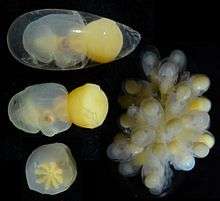Seven-arm octopus
| Seven-Armed Octopus | |
|---|---|
.jpg) | |
| Ventral view of young female (70 mm ML) | |
 | |
| Lateral view of young male | |
| Scientific classification | |
| Kingdom: | Animalia |
| Phylum: | Mollusca |
| Class: | Cephalopoda |
| Order: | Octopoda |
| Superfamily: | Argonautoida |
| Family: | Alloposidae Verrill, 1881 |
| Genus: | Haliphron Steenstrup, 1861 |
| Species: | H. atlanticus |
| Binomial name | |
| Haliphron atlanticus Steenstrup, 1861 | |
| Synonyms | |
| |
The seven-arm octopus (Haliphron atlanticus) is one of the two largest known species of octopus; based on scientific records, it has a maximum estimated total length of 3.5 m (11 ft) and mass of 75 kg (165 lb).[1][2] The only other similarly large extant species is the giant Pacific octopus, Enteroctopus dofleini.
The genera Alloposina Grimpe, 1922, Alloposus Verrill, 1880 and Heptapus Joubin, 1929 are junior synonyms of Haliphron.
Description

The seven-arm octopus is so named because in males the hectocotylus (a specially modified arm used in egg fertilization) is coiled in a sac beneath the right eye. Due to this species' thick gelatinous tissue, the arm is easily overlooked, giving the appearance of just seven arms. However, like other octopuses, it actually has eight.
Distribution
The type specimen of H. atlanticus was collected in the Atlantic Ocean at 38°N 34°W / 38°N 34°W. It is deposited at the Zoologisk Museum, University of Copenhagen.[3]
In 2002, a single specimen of giant proportions was caught by fishermen trawling off the eastern Chatham Rise, New Zealand. This specimen, the largest of this species and of all octopi, was the first validated record of Haliphron from the South Pacific. It had a mantle length of 0.69 m (2.3 ft), a total length of 2.90 m (9.5 ft), and a weight of 61.0 kg (134.5 lb), although it was incomplete.
.jpg)
.jpg)
See also
References
- ↑ O'Shea, S. (2004). "The giant octopus Haliphron atlanticus (Mollusca : Octopoda) in New Zealand waters". New Zealand Journal of Zoology. 31 (1): 7–13. doi:10.1080/03014223.2004.9518353.
- ↑ O'Shea, S. (2002). "Haliphron atlanticus — a giant gelatinous octopus" (PDF). Biodiversity Update. 5: 1.
- ↑ Current Classification of Recent Cephalopoda
Further reading
- Bakken, T. & T. Holthe 2002. Haliphron atlanticum (Cephalopoda, Alloposidae) caught in Skorafjorden (64°N), Norway. Fauna norv. 22: 37-38.
- Willassen, E. 1986. Haliphron atlanticus Steenstrup (Cephalopoda: Octopoda) from the coast of Norway. Sarsia 71: 35-40.
External links
- "CephBase: Seven-arm octopus". Archived from the original on 2005.
- Tree of Life web project: Haliphron atlanticus
- The giant octopus Haliphron atlanticus (Mollusca: Octopoda) in New Zealand waters
- BBC News: Giant octopus puzzles scientists
- Tony Wu Underwater Photography: Seven-arm octopus